Central Bank Watch Overview:
- As their economies have handled the coronavirus pandemic well thus far, the trio of central banks associated with the Australian, Canadian, and New Zealand Dollars are in a holding pattern.
- Although there are some signs that re-openings are leading to rising COVID-19 caseloads again, it’s too early to say that progress will need to be rolled back. There’s little compelling reason for the BOC, RBA, and RBNZ to move interest rates away from current levels, enhanced by QE.
- Retail trader positioning suggests that the commodity currencies are on mostly neutral footing.



Easing is Here to Stay, for 2020 and Beyond
The global economy continues to inch forward towards re-opening amid the coronavirus pandemic, but that doesn’t mean uncertainty has disappeared from the economic outlook – or from financial markets. As their economies have handled the coronavirus pandemic well thus far, the trio of central banks associated with the Australian, Canadian, and New Zealand Dollars are in a holding pattern. Nevertheless, there’s little compelling reason for the BOC, RBA, and RBNZ to move interest rates away from current levels during, enhanced by QE, through 2020 (and likely beyond).
We will continue to monitor the commodity currencies in particular, as even though the Australian, Canadian, and New Zealand Dollars no longer hold the relative yield advantage that defined ‘the carry trade,’ these currencies retain significant economic exposure to agriculture and base metals, making them prime vehicles for speculation around a rebound in global growth. As such, market-based measures of interest rate expectations will prove sensitive to investors’ concerns regarding the global economy’s economic rebound.
Bank of Canada Due to Stand Pat Through 2020
Bank of Canada interest rate expectations have been stable for several weeks at this point in time. At the end of April, there was a 55% chance of a 25-bps interest rate cut in December 2020, according to Canada overnight index swaps. But given gains in global equity and energy markets, and containment of the coronavirus pandemic within Canada’s borders, a bullish foundation has been laid for the Canadian Dollar. To this end, there is a 6% chance of a 25-bps rate cut through December 2020.
Bank of Canada Interest Rate Expectations (JULY 23, 2020) (Table 1)
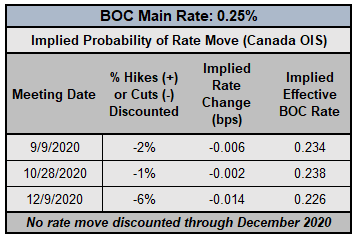
It still holds that the Bank of Canada’s efforts along the interest rate front are finished. While the BOC has cut the main interest rate to an all-time low of 0.25%, there have been some signals to the market that it may not be done yet (see: the two most recent BOC meetings). If the BOC does anything else, it may not be to cut interest rates to zero – or to negative territory. Whereas the threat of negative rates looms for other major currencies (see: New Zealand Dollar), the Canadian Dollar is not haunted by this threat.
IG Client Sentiment Index: USD/CAD Rate Forecast (JULY 23, 2020) (Chart 1)
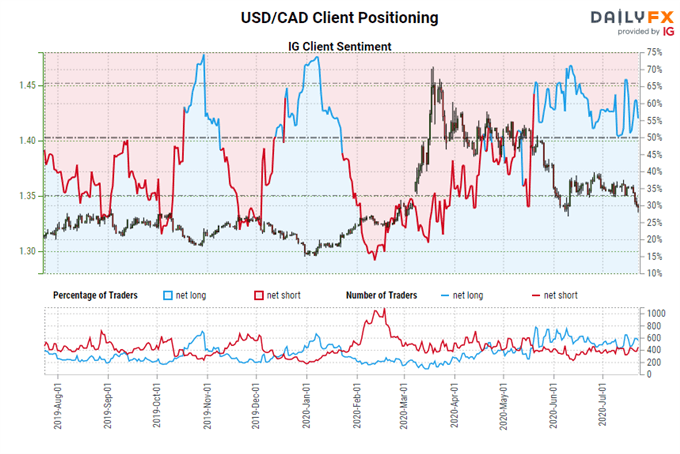
USD/CAD: Retail trader data shows 58.55% of traders are net-long with the ratio of traders long to short at 1.41 to 1. The number of traders net-long is 6.28% higher than yesterday and 16.67% lower from last week, while the number of traders net-short is 13.95% lower than yesterday and 26.79% higher from last week.
We typically take a contrarian view to crowd sentiment, and the fact traders are net-long suggests USD/CAD prices may continue to fall.
Positioning is more net-long than yesterday but less net-long from last week. The combination of current sentiment and recent changes gives us a further mixed USD/CAD trading bias.
Reserve Bank of Australia Jawbones into Yield Curve Control
The Reserve Bank of Australia’s June policy meeting came and went without much fanfare, failing to produce an interest rate cut despite markets pricing in the possibility (more on this below). In recent months, the RBA has already dropped its main overnight interest to an all-time low of 0.25%, implemented its own quantitative easing (QE) program, and issuing forward guidance to keep the three-year bond yield at 0.25% for the next three years.
RESERVE BANK OF AUSTRALIA INTEREST RATE EXPECTATIONS (JULY 23, 2020) (TABLE 2)
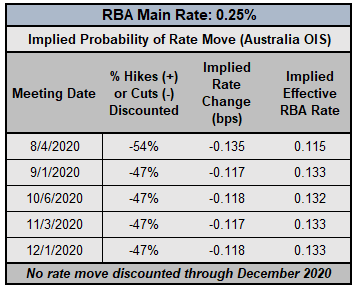
According to Australia overnight index swaps, there is a 54% chance of a 25-bps rate cut at the August RBA meeting. But as the commentary from RBA Governor Lowe would suggest, the central bank is not ready to move rates into negative territory, making any further rate cuts unlikely; the pricing may be a quirk due to the shape of the Australian bond yield curve.
Recall that the RBA, under Governor Lowe’s leadership, has said that it will target the three-year bond yield at 0.25% – the same rate as the overnight cash rate – which is a reasonable assumption that the RBA will keeping its overnight cash rate at 0.25% or lower for at least the next three years.
IG Client Sentiment Index: AUD/USD Rate Forecast (JULY 23, 2020) (Chart 2)
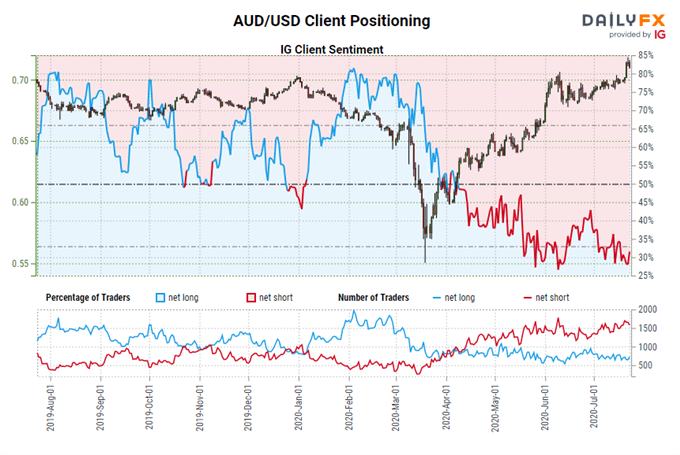
AUD/USD: Retail trader data shows 33.42% of traders are net-long with the ratio of traders short to long at 1.99 to 1. The number of traders net-long is 9.05% higher than yesterday and 4.41% lower from last week, while the number of traders net-short is 3.69% lower than yesterday and 7.75% lower from last week.
We typically take a contrarian view to crowd sentiment, and the fact traders are net-short suggests AUD/USD prices may continue to rise.
Yet traders are less net-short than yesterday and compared with last week. Recent changes in sentiment warn that the current AUD/USD price trend may soon reverse lower despite the fact traders remain net-short.
Reserve Bank of New Zealand Considering Negative Rates?
Nothing has changed for the Reserve Bank of New Zealand since convening their emergency meeting on March 16, where they slashed the main overnight cash rate by 75-bps to an all-time low of 0.25%. The coronavirus pandemic has not hit the New Zealand economy has hard as other developed economies – New Zealand hasn’t reported a new infection in a week - but that hasn’t stopped the RBNZ from going to its most extreme easing stance in its history in order to buffer the economy from contagion.
To this end, as part of the emergency interest rate cut, the RBNZ made clear that it would begin forward guidance, indicating that the main interest rate would stay at 0.25% for at least the next 12-months. But that doesn’t more can’t be done: the RBNZ noted that 0.25% “was currently the lower limit, given the operational readiness of the financial system for very low or negative interest rates.”
But at the May RBNZ meeting, the tone changed. “The committee noted that a negative official cash rate will become an option in the future, although at present financial institutions are not yet operationally ready,” the RBNZ said.“It was noted that discussions with financial institutions about preparing for a negative OCR are ongoing," which "will become an option" in 2021.
The story has evolved further in recent weeks. In an interview at the end of June, when asked about the possibility of negative interest rates, Governor Orr said "We could…we've been saying to banks, 'get your act together, be prepared, make sure you're able to put a negative sign in front of your wholesale interest rates if we need to go there'."
RESERVE BANK OF NEW ZEALAND INTEREST RATE EXPECTATIONS (JULY 23, 2020) (Table 3)
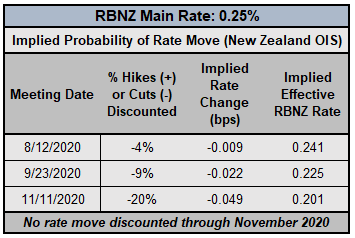
The RBNZ interest rate expectations curve is still suggesting there’s a chance that negative rates emerge this year, but only a 1-in-5 shot; 20%. Contextually, this is not a significant improvement: while it is higher than the 16% or so seen in the last iteration in this report, the November rate cut pricing is still below where it was in May, when it peaked just below 30%.
IG Client Sentiment Index: NZD/USD Rate Forecast (July 23, 2020) (Chart 3)
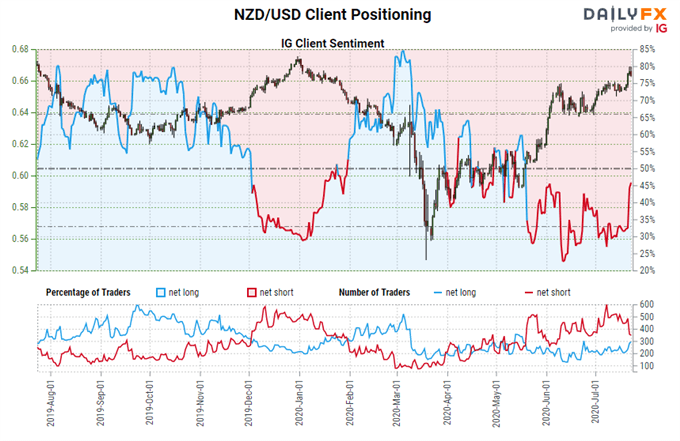
NZD/USD: Retail trader data shows 42.65% of traders are net-long with the ratio of traders short to long at 1.34 to 1. The number of traders net-long is 11.11% lower than yesterday and 19.46% higher from last week, while the number of traders net-short is 3.20% higher than yesterday and 28.28% lower from last week.
We typically take a contrarian view to crowd sentiment, and the fact traders are net-short suggests NZD/USD prices may continue to rise.
Positioning is more net-short than yesterday but less net-short from last week. The combination of current sentiment and recent changes gives us a further mixed NZD/USD trading bias.



Read more: Gold Price Forecast: All-Time Highs Come into Focus - Key Levels for XAU/USD
--- Written by Christopher Vecchio, CFA, Senior Currency Strategist





